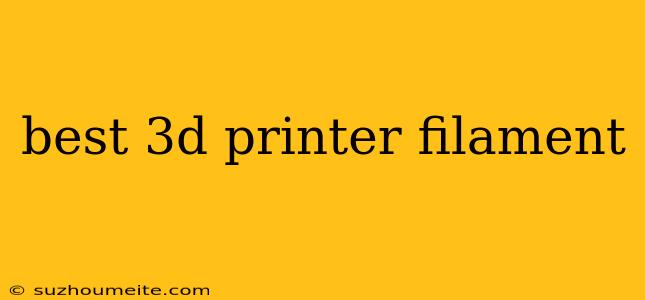Best 3D Printer Filament: A Comprehensive Guide
The right filament can make or break your 3D printing experience. With so many options available, choosing the best 3D printer filament for your needs can be overwhelming. This guide will help you understand the different types of filament, their properties, and what to consider when making your choice.
Types of 3D Printer Filament:
1. PLA (Polylactic Acid):
- Pros: Biodegradable, easy to print, wide range of colors, relatively inexpensive.
- Cons: Low heat resistance, brittle, prone to warping.
- Ideal for: Prototyping, hobby projects, functional prints that won't be exposed to high temperatures.
2. ABS (Acrylonitrile Butadine Styrene):
- Pros: Strong, durable, high heat resistance, good impact strength.
- Cons: More difficult to print, requires heated bed, prone to warping.
- Ideal for: Durable parts, mechanical components, prototypes that need to withstand high temperatures.
3. PETG (Polyethylene Terephthalate Glycol):
- Pros: Tough, flexible, good heat resistance, easy to print, less warping than ABS.
- Cons: More expensive than PLA, can be brittle at lower temperatures.
- Ideal for: Durable prints, food-safe applications, bottles, containers, and other objects that require flexibility.
4. Nylon (Polyamide):
- Pros: Strong, durable, flexible, high heat resistance, good chemical resistance.
- Cons: Can be difficult to print, requires heated bed, prone to warping.
- Ideal for: High-performance parts, mechanical components, outdoor applications.
5. TPU (Thermoplastic Polyurethane):
- Pros: Extremely flexible, durable, good abrasion resistance, good chemical resistance.
- Cons: Can be difficult to print, requires heated bed, prone to stringing.
- Ideal for: Flexible parts, seals, gaskets, and other applications that require elasticity.
6. Carbon Fiber Reinforced Filament:
- Pros: Increased strength and stiffness, improved dimensional stability, better heat resistance.
- Cons: More expensive, can be abrasive on nozzles.
- Ideal for: High-performance parts, structural components, aerospace applications.
Factors to Consider When Choosing 3D Printer Filament:
- Your 3D Printer: Ensure the filament is compatible with your printer's hotend temperature range and nozzle size.
- Project Requirements: Determine the necessary properties for your print, such as strength, flexibility, heat resistance, or chemical resistance.
- Budget: Filament prices vary significantly depending on material and brand.
- Ease of Printing: Some filaments are easier to print than others, so consider your experience level.
- Color Options: Filament is available in a vast range of colors, so choose one that suits your project.
Conclusion:
Choosing the right filament for your 3D printer is crucial for achieving successful and high-quality prints. By considering the different types of filament, their properties, and the factors mentioned above, you can select the best filament for your specific needs.
